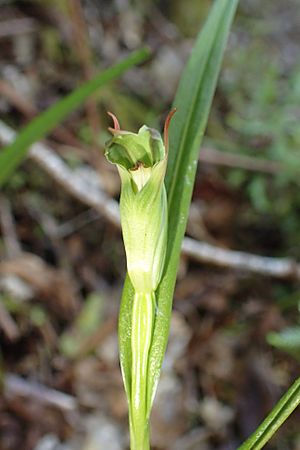Grass-leaved greenhood facts for kids
Quick facts for kids Grass-leaved greenhood |
|
|---|---|
 |
|
| Pterostylis graminea growing near Waitakere | |
| Scientific classification | |
| Genus: |
Pterostylis
|
| Species: |
graminea
|
Pterostylis graminea, often called the grass-leaved greenhood, is a type of orchid. It is found only in New Zealand. This plant has tall, thin leaves that look like grass. Its flower is yellowish-green with clear white stripes. The top leaves grow taller than the flower itself.
What it Looks Like
The grass-leaved greenhood is a plant that grows from an underground tuber. A tuber is like a small, round storage part of the plant. This plant is a perennial, meaning it lives for more than two years. It is also deciduous, so its leaves die back each year.
It usually has four to six leaves that stand straight up. These leaves are shaped like a spear or a blade of grass. They are V-shaped when you look at them closely. The leaves can be about 8 to 15 centimeters (3 to 6 inches) long and 0.5 to 1 centimeter (0.2 to 0.4 inches) wide. The leaves at the very top are the longest and grow higher than the flower.
Each plant has one yellowish-green flower with clear white stripes. This flower grows on a stem that can be up to 33 centimeters (13 inches) tall. The top part of the flower, called the dorsal sepal, and the petals are joined together. They form a hood shape over the plant's central part, which is called the column.
The dorsal sepal stands mostly upright at its base. Then, it suddenly bends forward and points downwards. The petals are a bit wider and slightly shorter than the dorsal sepal. There is a clear space between the side parts of the flower (lateral sepals) and the hood. These side parts have thin, thread-like tips that stand up. They spread out a little and are taller than the hood.
The lip of the flower, called the labellum, is greenish-brown. It is darker near its tip. This labellum is curved and sticks out above the opening of the flower. You can see these flowers blooming between September and January.
How it Got its Name
The grass-leaved greenhood was first officially described in 1853. A scientist named Joseph Dalton Hooker gave it its formal name. He wrote about it in a book called The Botany of the Antarctic Voyage.
The second part of its scientific name, graminea, comes from a Latin word. It means "of grass" or "grassy." This name perfectly describes its grass-like leaves.
Where it Grows
You can find the grass-leaved greenhood growing in forests and bushy areas. Sometimes, it also grows near the edges of wetlands. It lives on both the North Island and the South Island of New Zealand. It also grows on Stewart Island. This plant can be found at different heights, up to about 1,000 meters (3,300 feet) above sea level.

